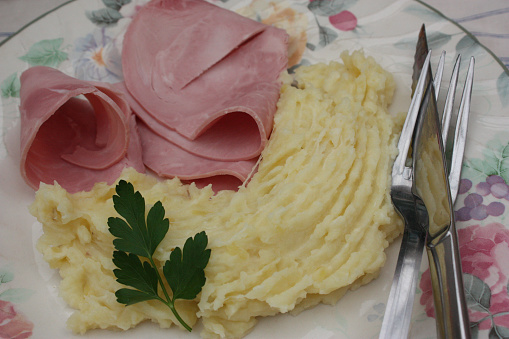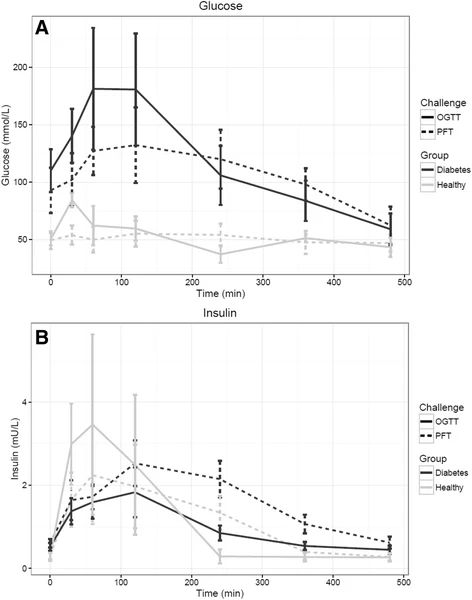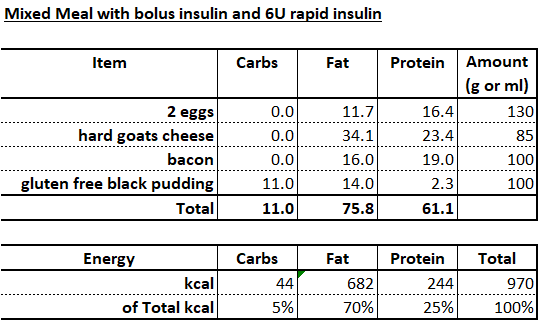The utility of mixed meal tolerance tests
Although a lot of useful data can be extracted from an oral glucose tolerance test (OGTT), it does not really resemble any real-life scenarios. After all, nobody consumes pure glucose, not even those who love to chew on white bread. The enormous amount of data, which is available in the literature derived from OGTTs [1], enables us to identify certain patterns, even if these show very minor differences. However, other nutrients, especially macronutrients as protein and fat, masks these subtle alterations in curve patterns, thus making it difficult to distinguish various stages on the metabolic health spectrum [2]. Eventually, measuring only glucose becomes insufficient in mixed meal contexts.
Unfortunately, the amount of research data on mixed meal ingestion, and subsequent patterns shown by healthy, insulin resistant (IR) and diabetic individuals is much less abundant. What is more, methods vary considerably more than what is seen in OGTTs, thereby making interpretation challenging. However, there has been efforts to standardize mixed meal (tolerance) tests, and the best outcome seems to be the one used in the PhenFlex challenge. Therefore, we tried to create a simple meal that can be easily prepared at home from widely available ingredients, but one that still resembles the original, otherwise made of purified and single macronutrient ingredients (palm olein, glucose and dairy protein). [1] Another aspect that needs consideration is the length and sampling frequency in a postprandial challenge. Fortunately, some studies did extensive testing to guide us, concluding that there is very little value in extending sampling beyond 5 hours, but already a 2-3-hour long test can often be informative. [3]

I include a pair graphs from a study that used the mentioned method and enrolled 40 males (20 healthy and 20 type 2 diabetics). [4] Due to the fact that insulin resistant/diabetic individuals typically return to baseline much more slowly than healthy people, if no previous evaluation of metabolic flexibility/IR had been done extended sampling is recommended. Even in this case, 5 hours must be sufficient. Previous verification of insulin sensitivity enables a shorter test window of 3-4 hours.
To avoid physiological glucose sparing (often called physiological IR) from kicking in, mixed meal tolerance test participants are advised to increase their dietary carbohydrate content to 1.5-2 g/kg body weight 2 weeks prior to undergoing the experimental protocol. Carbohydrate restriction, especially when combined with high fat intake, has been long known to interfere with glucose production and utilization. [5] It was even shown that carbohydrate intake should be “normal” the evening before undergoing an oral glucose tolerance test. [6] More recently, the underlying mechanism was also partly discovered. [7] The so-called carb-up procedure can be gradual to avoid high stress by elevated glucose levels, for example increasing carbohydrate intake by 20-30 g/d until the recommended 1.5-2 g/kg BW is reached.
Another factor that can influence morning metabolic responses is the timing of the last meal the evening before. A very recent study showed that a late dinner, one that results in a long postprandial period while already sleeping, increases cortisol and reduces glucose tolerance for the following many hours. [8]

Basic concept: large meal (~1,060 kcal), moderate-low protein, OGTT-level carbohydrate and high fat content. Fatty acid distribution is a mix of animal body fat and dairy fat. In contrast to typical design, potatoes were selected as the carbohydrate source, because of their potassium and plant protein content. To comply with various religious restrictions, pork products (e.g. meat and lard) were excluded, but anything can easily be used by quickly entering it into the basic calculator provided on our forums.
Main constituents: Turkey ham, boiled potatoes, and heavy cream. Macronutrient composition goal: 25 g protein (90 kcal, ~8 %), 75 g fat (670 kcal, ~63 %), and 75 g carbohydrate (308 kcal, 29 %) The test is standardized for a 75 kg (165 lbs) average human and can be adjusted to actual body weight by linear extrapolation.

Food items used for calculations:

References
- Phenotypic flexibility as a measure of health: the optimal nutritional stress response test https://genesandnutrition.biomedcentral.com/articles/10.1007/s12263-015-0459-1
- Mixed meal ingestion diminishes glucose excursion in comparison with glucose ingestion via several adaptive mechanisms in people with and without type 2 diabetes https://dom-pubs.onlinelibrary.wiley.com/doi/full/10.1111/dom.12570
- Two-Hour Seven-Sample Oral Glucose Tolerance Test and Meal Protocol https://diabetes.diabetesjournals.org/content/54/11/3265
- Multi-parameter comparison of a standardized mixed meal tolerance test in healthy and type 2 diabetic subjects: the PhenFlex challenge https://link.springer.com/article/10.1186/s12263-017-0570-6
- Effects of carbohydrate restriction on glucose tolerance of normal men and reactive hypoglycemic patients https://academic.oup.com/ajcn/article-abstract/28/7/748/4716486
- Low carbohydrate intake bepfore oral glucose-tolerance tests https://www.thelancet.com/journals/lancet/article/PIIS0140-6736(05)60263-2/fulltext
- Prolonged fasting-induced metabolic signatures in human skeletal muscle of lean and obese men https://journals.plos.org/plosone/article?id=10.1371/journal.pone.0200817
- Metabolic Effects of Late Dinner in Healthy Volunteers – A Randomized Crossover Clinical Trial https://academic.oup.com/jcem/advance-article/doi/10.1210/clinem/dgaa354/5855227
Summary
To summarize good practices that should be considered in connection with a mixed meal tolerance test, but also for an oral glucose tolerance test:
- Include ample amounts of carbohydrates (~0.8-1 g/kg BW) in the meal the evening before taking the test.
- Fast at least 10 hours before taking the test. If you had high amounts of fat in the last meal the evening before this window should be extended to 12 or even to 14 hours, depending on the amount of fat.
- Those who have been following a carbohydrate restricted diet should add 1.5-2 g/kg BW carbohydrates for 10-15 days prior to taking the test. Pro tip: slow absorbing types and placing them after a regular whole ingredients-based meal can regulate blood glucose and insulin levels in a way that is not detrimental.
- For the reason mentioned above, consume the ingredients (meat and fatty mashed potatoes) together, so that results are not influenced by food order.
- Leave at least 5 hours between the evening meal and going to bed.
